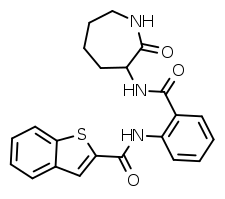ANA-12
ANA-12 is a selective, small-molecule non-competitive antagonist of TrkB (Kd = 10 nM and 12 μM for the high- and low-affinity sites, respectively), the main receptor of brain-derived neurotrophic factor (BDNF).[1] The compound crosses the blood-brain-barrier and exerts central TrkB blockade, producing effects as early as 30 minutes (~400 nM) and as long as 6 hours (~10 nM) following intraperitoneal injection in mice.[1] It blocks the neurotrophic actions of BDNF without compromising neuron survival.[1]
 | |
| Clinical data | |
|---|---|
| ATC code |
|
| Identifiers | |
| |
| CAS Number | |
| PubChem CID | |
| ChemSpider | |
| ECHA InfoCard | 100.229.925 |
| Chemical and physical data | |
| Formula | C22H21N3O3S |
| Molar mass | 407.49 g·mol−1 |
| 3D model (JSmol) | |
| |
| |
Research
ANA-12 produces rapid antidepressant- and anxiolytic-like effects in animal models,[1] the former of which have been elucidated to be mediated by blockade of BDNF signaling in the nucleus accumbens.[2][3] It has also been found to alleviate methamphetamine-induced depression-like behavior (including anhedonia), behavioral sensitization, and nucleus accumbens neuroplasticity changes with subchronic (14-day) administration in mice, whereas the TrkB agonist 7,8-dihydroxyflavone was ineffective in doing so.[4]
ANA-12 blocks the cognitive-enhancing effects of environmental enrichment and calorie restriction in rodents, which are mediated by BDNF signaling through TrkB in the hippocampus.[5][6] It also blocks hippocampal neurogenesis induced by physical exercise in rodents, and may block the cognitive-enhancing effects of exercise as well.[7]
References
- Cazorla, Maxime; Prémont, Joël; Mann, Andre; Girard, Nicolas; Kellendonk, Christoph; Rognan, Didier (2011). "Identification of a low–molecular weight TrkB antagonist with anxiolytic and antidepressant activity in mice". Journal of Clinical Investigation. 121 (5): 1846–1857. doi:10.1172/JCI43992. ISSN 0021-9738. PMC 3083767. PMID 21505263.
- Zhang JC, Wu J, Fujita Y, Yao W, Ren Q, Yang C, Li SX, Shirayama Y, Hashimoto K (2015). "Antidepressant effects of TrkB ligands on depression-like behavior and dendritic changes in mice after inflammation". Int. J. Neuropsychopharmacol. 18 (4): pyu077. doi:10.1093/ijnp/pyu077. PMC 4360225. PMID 25628381.
- Shirayama Y, Yang C, Zhang JC, Ren Q, Yao W, Hashimoto K (2015). "Alterations in brain-derived neurotrophic factor (BDNF) and its precursor proBDNF in the brain regions of a learned helplessness rat model and the antidepressant effects of a TrkB agonist and antagonist". Eur Neuropsychopharmacol. 25 (12): 2449–58. doi:10.1016/j.euroneuro.2015.09.002. PMID 26419294.
- Ren Q, Ma M, Yang C, Zhang JC, Yao W, Hashimoto K (2015). "BDNF-TrkB signaling in the nucleus accumbens shell of mice has key role in methamphetamine withdrawal symptoms". Transl Psychiatry. 5 (10): e666. doi:10.1038/tp.2015.157. PMC 4930133. PMID 26506052.
- Fan D, Li J, Zheng B, Hua L, Zuo Z (2016). "Enriched Environment Attenuates Surgery-Induced Impairment of Learning, Memory, and Neurogenesis Possibly by Preserving BDNF Expression". Mol. Neurobiol. 53 (1): 344–54. doi:10.1007/s12035-014-9013-1. PMID 25432890.
- Kishi T, Hirooka Y, Nagayama T, Isegawa K, Katsuki M, Takesue K, Sunagawa K (2015). "Calorie restriction improves cognitive decline via up-regulation of brain-derived neurotrophic factor: tropomyosin-related kinase B in hippocampus of obesity-induced hypertensive rats". Int Heart J. 56 (1): 110–5. doi:10.1536/ihj.14-168. PMID 25503654.
- Ambrogini, P.; Lattanzi, D.; Ciuffoli, S.; Betti, M.; Fanelli, M.; Cuppini, R. (2013). "Physical exercise and environment exploration affect synaptogenesis in adult-generated neurons in the rat dentate gyrus: Possible role of BDNF". Brain Research. 1534: 1–12. doi:10.1016/j.brainres.2013.08.023. ISSN 0006-8993. PMID 23973748.